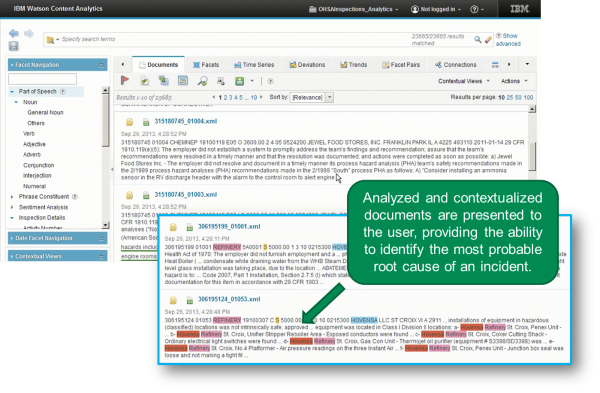Earlier this year, we examined how IBM Watson can help healthcare organizations analyze vast quantities of unstructured data to gain quick insights from previously untapped data sources. We found that the content analytics solution, along with IBM’s healthcare tools and accelerators, uncovers valuable intelligence from disparate healthcare data and content, including physician notes, patient surveys, call center recordings and diagnosis reports – information that is often saved in a free-form text format and is rarely used for analytics.
Incident Analysis Challenges
Most recently, Perficient looked into applying those same concepts of unstructured data and content analysis within another area challenged with increasing volumes of complex documents, asset management and heavy regulations – Incident Management, Analysis and Resolution.
Aging infrastructure, retiring knowledge workers and high turnover with existing employees is negatively impacting the knowledge base around asset management and incident resolution. Reduced infrastructure and funding for capital expenses requires companies to increase the lifespan of investments, rather than secure funds for new purchases. Creating a proactive incident mitigation plan to reduce the rate of future incidents and improve asset management would greatly reduce large infrastructure expenses and limit the risk associated with incidents.
Currently, across a variety of industries, there is very little automation within the incident reporting process space. Incident reporting usually occurs via telephone or email, and reports are manually generated. As a result, operations departments find it cumbersome to organize and process all data related to the root cause analysis of the incident event.
How can Watson Explorer help?
Incident analysis with Watson content analytics (a component of Watson Explorer) allows investigators to identify incident relationships, visualize trends and spot correlations, with an intuitive, easy-to-use interface. An incident inspector or investigator would use the content analytics solution to identify the root cause of an incident. Analyzed and contextualized documents are presented to the user, providing the ability to identify the most probable root cause of incidents. Documents may include inspection results, case notes, equipment/asset documentation, and maintenance logs, among others. Watson finds problems that caused several incidents and would most likely go undiscovered, not just issues with the highest frequency.

Watson allows businesses to move beyond simple incident identification and reactive resolution. With trend and pattern analysis, companies can identify which assets or pieces of equipment are most likely to cause points of failure, fixing the problematic component before it results in an incident. By reducing the rate of preventable incidents, Watson can help mitigate unnecessary risk in any industry challenged with large volumes of complex assets: energy and utilities, manufacturing, transportation, etc. By creating a proactive plan to prevent failures, the solution helps extend the life of assets and reduce avoidable capital expenditures. And by building an incident analysis platform that codifies best practices from industries and knowledge workers, companies can better adapt to a changing workforce.
World of Watson
 If you’re interested in hearing more about use cases and applications of Watson – both the content analytics solution and the cognitive analytics engine, check out IBM’s upcoming World of Watson event in NYC. This event and related hackathon, run May 4-6 at the Duggal Greenhouse in Brooklyn, NY. Perficient is exhibiting at the event, along with a select group of IBM business partners that are on the cutting edge of Watson application development. We’ll provide demos of the Watson content analytics incident analysis solution covered in this post, and discuss our experiences with the Watson Explorer platform.
If you’re interested in hearing more about use cases and applications of Watson – both the content analytics solution and the cognitive analytics engine, check out IBM’s upcoming World of Watson event in NYC. This event and related hackathon, run May 4-6 at the Duggal Greenhouse in Brooklyn, NY. Perficient is exhibiting at the event, along with a select group of IBM business partners that are on the cutting edge of Watson application development. We’ll provide demos of the Watson content analytics incident analysis solution covered in this post, and discuss our experiences with the Watson Explorer platform.
